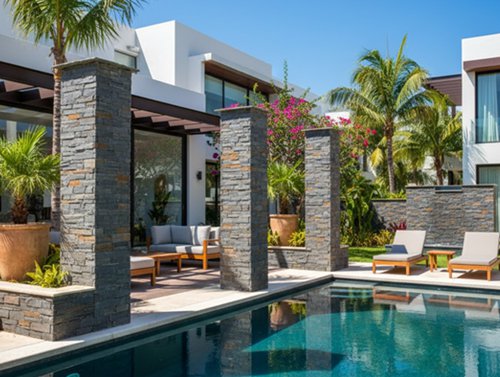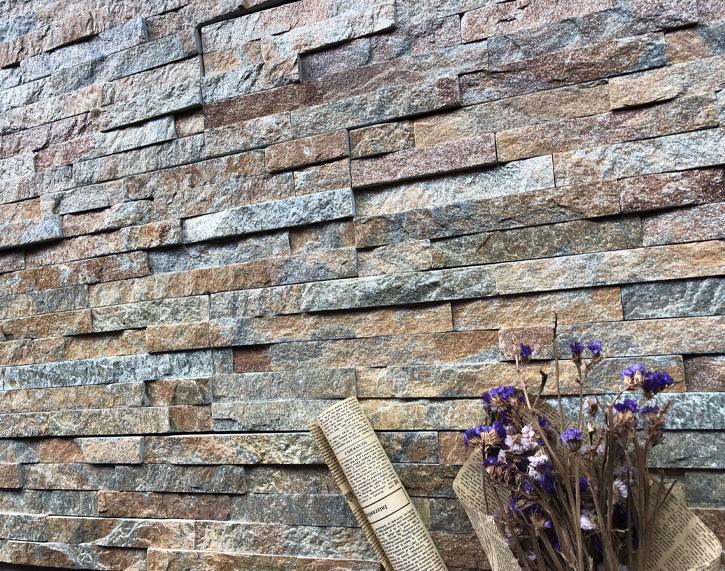Stacked stone is a masonry material composed of natural or manufactured stone pieces layered horizontally for use in outdoor architectural features. For professionals, it offers lasting weather resistance, ease of installation, and aesthetic versatility—qualities that enhance curb appeal and project value. This article outlines essential applications, design considerations, and installation best practices for using stacked stone in exterior settings.
1. Frame Your Entryway with Stacked Stone Columns
Defining the Entry with Curb Appeal
Stacked stone columns establish architectural presence at entrances, creating a clear transition from street to home. These columns convey quality and permanence, serving both structural and visual purposes.
Natural stacked stone offers a textured appearance that ages well and requires minimal maintenance. Unlike painted finishes, stone resists UV damage, extreme temperatures, and moisture, maintaining its look for decades.
Column installations are highly adaptable—surround a single door for understated refinement, or flank both sides of a porch for a formal entry. The layered stone surface captures light and shadow, enhancing depth and elevating the home’s street presence without major renovation.

2. Define Your Landscape with Stone Borders and Low Walls
Stacked stone borders and low walls deliver structure and definition to outdoor environments. These features organize garden beds, separate lawns from pathways, and create clear zones while introducing the natural texture of stone to landscape design.
Organizing with Stacked Stone Borders
Stone borders contain soil and mulch, preventing plant overgrowth and providing a clean transition between different landscape elements. Moderately tall borders made from flat-faced stone pieces minimize maintenance by deterring weed migration and soil erosion.
Niedrig retaining walls constructed from stacked stone can serve as informal seating or manage water drainage on sloped terrain. Terracing with stone introduces planting space where none existed, and the tactile surface softens the hard edges of driveways and paths. This approach brings definition and character to any landscape.
3. Design a Weatherproof Outdoor Kitchen with Stacked Stone
Designing Weatherproof Outdoor Kitchens
Stacked stone elevates outdoor kitchens into integrated, visually appealing extensions of the home. Wrapping grill islands, bars, or counters in Hauptbuchstein creates design continuity across patios and exterior walls for a cohesive effect.
Stone delivers natural durability, standing up to heat, spills, and weather. Both natural stone and quality veneer withstand temperature swings and moisture exposure while being easy to clean, allowing for low-maintenance operation in outdoor environments.
Designs can focus on a single feature, such as the grill surround, or expand to entire kitchen perimeters. Regardless of scope, using stone provides refined appearance and long-term reliability under regular use and varied conditions.
Bring Lasting Natural Stone Beauty to Your Projects
Transform spaces with authentic, durable ledger stone—each panel crafted for easy installation, timeless style, and true architectural versatility. Backed by advanced manufacturing and strict quality checks, our panels offer the character of real stone with streamlined logistics and personalized wholesale support. Enhance value and confidence in every build or design.

4. Create a Focal Point with a Stacked Stone Fire Pit
Encircling a fire pit with gestapelter Stein creates a permanent, fireproof focal point in backyard environments. The stone withstands direct heat without degrading, delivering both safety and consistency for long-term use. This approach provides an inviting setting for gatherings while visually anchoring the outdoor area.
Building Lasting Fire Pit Features
Stacked stone suits both circular and square fire pit designs, aligning with various landscape layouts. Extending stonework to seating walls or into patio transitions creates design continuity and flow. The stone’s heat resistance minimizes maintenance and the need for frequent repairs.
A stable fire pit requires a gravel base and effective drainage to prevent water accumulation. Installing these foundational elements preserves structural integrity through freeze-thaw cycles and heavy rainfall, ensuring reliable performance with limited upkeep.
5. Add Natural Serenity with a Stone Water Feature
Stacked stone water features introduce movement and aural interest while establishing a natural textural foundation within outdoor designs. Ledger stone panels or fieldstone assemblies function as effective backdrops for waterfalls, pondless fountains, or bubbling rock installations. The material’s layered surface interacts with light and water, providing visual depth without complex engineering.
Placement is key—integrating water features near established stone elements or open beds ensures cohesion with adjacent plantings and hardscape. Stone color and texture should coordinate with the overall landscape: cool grays support modern environments, warmer tones suit rustic or cottage settings.
Designing Waterfalls and Fountains with Ledger Stone
Ledger stone’s flat orientation simplifies waterfall construction, providing natural channels for water flow. Place landscape fabric below the feature for weed control, and build on a gravel base for drainage and stability. This reduces maintenance issues such as algae and soil erosion around the fountain.
Select low-maintenance plantings—such as sedges, creeping Jenny, or blue fescue—around the installation to enhance its appearance without detracting from the stone and water. Keep arrangements minimal to maintain focus on the interaction between materials, and use gravel to delineate the edge of the feature.

6. Blend Textures by Combining Stacked Stone with Modern Materials
Integrating gestapelter Stein with materials like wood, metal, or stucco enables exterior spaces to balance tradition with contemporary appeal. This mixed-material strategy increases design versatility while leveraging the durability and presence of stone.
Integrating Mixed-Material Facades
Stone cladding combined with metal railings or horizontal wood slats updates traditional applications and introduces architectural contrast. Metal delivers a sharp, modern look, while wood adds natural warmth that complements the stone’s texture. These combinations create a unified exterior identity and connect the built environment to the landscape.
Layering materials allows clear zoning—stone grounds the structure, while lighter claddings or accents define visual hierarchy. This technique refreshes older exteriors without full reconstruction, mitigating monotony and offering design flexibility.
Installation Tips: Preparing Your Yard for Stacked Stone
Thorough site preparation is essential to prevent cracking or shifting and maximize the lifespan of any stacked stone installation. A properly constructed foundation safeguards project value and reduces long-term maintenance.
Site Preparation and Drainage Essentials
Excavate several inches below grade and use compacted gravel to create a solid base. Apply landscape fabric over the gravel for weed control while maintaining drainage. This establishes a stable platform for the stonework.
Install a perforated drainpipe behind retaining walls or borders and use gravel backfill to direct water away from stone surfaces. Standing water increases hydrostatic pressure, risking structural failure from freeze-thaw cycles or ground movement. For sloped sites, ensure runoff is directed toward designated drainage areas rather than pooling at the installation base.
Häufig gestellte Fragen
Is stacked stone durable enough for harsh outdoor climates?
Yes, both natural stone and quality manufactured veneer stand up well to extreme weather when properly installed. Natural stone offers excellent resistance to freeze-thaw cycles and UV exposure, while modern stone veneer products are engineered specifically for outdoor durability with minimal maintenance needs.
Does stacked stone need to be sealed for weather protection?
Sealing is recommended but not always required, depending on your stone type and climate. Natural stone benefits from a breathable sealer that prevents moisture penetration while allowing the material to release trapped water vapor. Most stone cladding panels come pre-finished and don’t need additional sealing.
Can stacked stone be installed on a curved wall?
Absolutely, and this is where stone veneer shines over full-weight natural stone. Thinner veneer pieces flex slightly and can be cut to fit curved surfaces, making them ideal for arched entryways or rounded garden walls. Work with smaller pieces and use flexible mortar for the best results on tight curves.
What’s the best type of stone for cold, freeze-thaw regions?
Dense, low-porosity stones like granite and certain quartzites handle freeze-thaw cycles best because they absorb less water. Fieldstone and manufactured stone designed for northern climates also perform well. Avoid highly porous limestone or sandstone in areas with repeated freezing unless you’re committed to regular sealing.
How does stacked stone compare to brick or concrete for outdoor projects?
Stacked stone offers more visual texture and a premium aesthetic that brick and concrete can’t match, especially for accent features like entryways and garden walls. While brick is uniform and concrete is cost-effective, stone provides organic variation and pairs beautifully with mixed-material designs. Installation costs for stone veneer fall between brick and poured concrete, making it a balanced choice for curb appeal projects.
Final Thoughts
Stacked stone delivers durable, low-maintenance solutions for exterior projects ranging from entry columns to landscape features and mixed-material facades. Both natural stone and cladding panels offer lasting visual appeal and adaptability for various design styles and climate conditions.
For optimal results, consult project guides or view portfolios aligned with your goals. Engaging with local stone suppliers or landscape professionals can help refine materials selection, cost planning, and installation logistics, ensuring your project distinguishes itself with confidence and long-term value.

